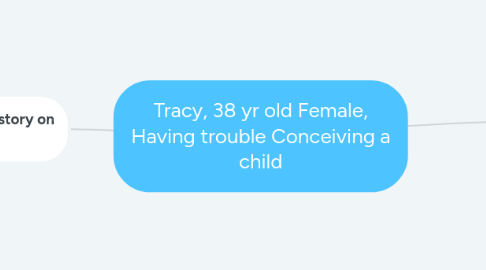
1. Infertility
1.1. Definition
1.1.1. Cannot conceive w/o birth control & regular intercourse after 6 months if woman is over 35
1.1.2. 10 in 100 woman age 15-44 have difficulty becoming pregnant
1.1.3. Secondary infertility = had one pregnancy, but unable to become pregnant again
1.2. Causes
1.2.1. Ovulation problems
1.2.1.1. Hormone imbalance
1.2.2. Blocked fallopian tubes
1.2.2.1. infection, surgery
1.2.3. Uterus issues
1.2.3.1. Fibroids
1.2.4. Risk factors
1.2.4.1. Smoking, Heavy Alcohol Use, Stress, Poor Diet, Diabetes, Overweight/umderweight, STD's causing PID, Endometriosis, PCOS or thyroid problems, Radiation or Chemo
1.3. Tests
1.3.1. Pelvic Exam
1.3.2. Ovulation predictor kit determines progesterone elvel on day 21 of menstrual cycle
1.3.3. Hormone level tests (FSH & AMH) in blood, can help determine quantity of woman's eggs
1.3.4. Examination of fallopian tube to determine blockage, X-ray hysterosalpingogram (HSG). Inject dye into uterus through cervix, take X-ray pictures to see if dye moves freely
1.4. Treatment
1.4.1. Clomiphene citrate, Letrozole, human menopausal gonadotropin, FSH, GnRH, metformin (women w/ diabetes), Bromocriptine
1.4.1.1. Stimulates ovulation in women
1.4.2. Intrauterine Insemination
1.4.2.1. Prepared sperm is injected in womans uterus, do this when there is unexplained infertility and woman has been ruled out as the problem
1.4.3. In vitro fertilization (IVF)
1.4.3.1. Remove mature eggs from woman's ovaries using needle, combine egg w/ sperm in lab and return embryos to woman's body
1.5. Source
1.5.1. Infertility https://www.cdc.gov/reproductivehealth/infertility/index.htm
2. Effect of Medical History on Pregnancy
2.1. SMA Carrier
2.1.1. autosomal recessive results in muscle weakness and atrophy in all patients, genetic testing is available, deficiency in SMN1 protein is the cause but the phenotype can be rescued by having more copies of SMN2 gene resulting in milder phenotype.
2.1.2. 4 types, since maternal grandmother had it, it is likely that she had either type 2, 3, or 4 which are less severe than type 0, 1.
2.1.2.1. Type 0 - death occurs by 1 month from respiratory failure, 1 copy of SMN2
2.1.2.2. Type 1 - Werdnig-Hoffmann disease, presents before 6 months, infant usually dies by 2 years, weak cry, poor suck, respiratory musclee weakness, "frog leg posture". 2/3 copies of SMN2
2.1.2.3. Type 2- intermediate form, presents between 3 and 15 months age, less severe, progressive scoliosis & restrictive lung disease, lose ability to sit independently in teenage years, 2/3 individuals make it to 25 . 3 copies of SMN2 gene
2.1.2.4. Type 3 - presents between 18 months until adulthood, chronic course, less severe, normal lifespan, many lose ability to walk with time, wheelchair dependent. 3/4 copies of SMN2 gene
2.1.2.5. Type 4 - adult onset, mildest form, less than 5 % of cases, patients live a normal lifespan. 4 to 8 copies of SMN2 gene
2.1.3. affected individuals with SMA & parents should be referred for genetic counseling
2.1.4. Treatment for SMA is mainly supportive, use of nutrition and respiratory assistance as needed, treating or preventing complications of weakness
2.1.5. Source: UptoDate Spinal Muscular Atrophy
2.2. Systemic Lupus Erythematosus (SLE)
2.2.1. Chronic Autoimmune Disease, can affect any organ in body
2.2.2. Higher maternal and fetal risk, preconception evaluation for risk assessment
2.2.2.1. Pregnancy has increased risk of disease flares. Patients w/ active SLE should defer pregnancy for 6 months until disease is well controlled (especially with lupus nephritis). Conception should be attempted in disease remission or stable disease on medication
2.2.2.2. Assessment of previous births, gestational age, preeclampsia, miscarraige, preterm birth for risk. Bloodwork is done as well to assess for antibodies, renal function, CBC, liver function, complement etc.
2.2.2.3. Recent stroke, cardiac involvement, pulmonary hypertension, lung disease, renal insufficiency are all high risk and gestational carriers or adoption should be suggested
2.2.2.4. Women with SLE have 2 to 4 times higher risk of preterm birth, unplanned C section, fetal growth restriction, preeclampsia and eclampsia. Also have risk of thrombosis, infection, thrombocytopenia and transfusion. Maternal mortality is 20 fold higher among women with SLE. Maternal fetal monitoring throughout pregnancy is important.
2.2.2.5. Women who have anti-Ro/SSA or anti-La/SSB antibodies have increased risk of developing congenital complete heart block or neonatal lupus. HCQ use decreases this risk. Increased surveillance for these patients
2.2.3. Medication management during pregnancys
2.2.3.1. Hydroxycholine can be continued, fewer disease flares have better outcomes in patients. Can also be used in breast feeding
2.2.3.2. Low dose asprin is administered at 12 weeks to reduce risk of preeclampsia regardless of antiphospholipid antibodies
2.2.3.3. NSAIDS to be avoided during conception and first trimester cycle, but can be used throughout pregnancy
2.2.3.4. Glucocorticoids --> suggest lowest dose of prednisone (less than 10 mg/day). Can also be used in breast feeding
2.2.4. Source: Uptodate - Pregnancy in women with systemic lupus erthematosus

